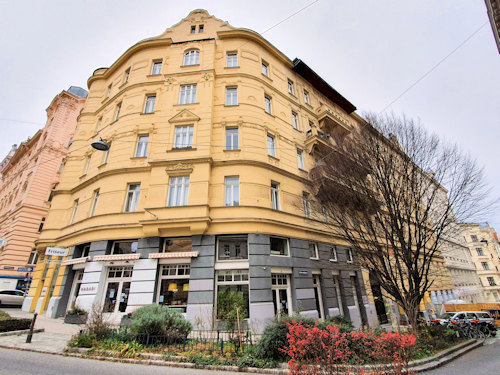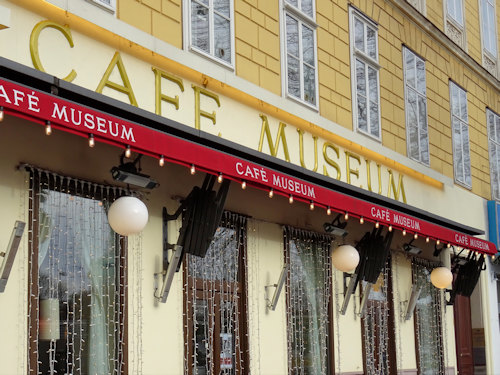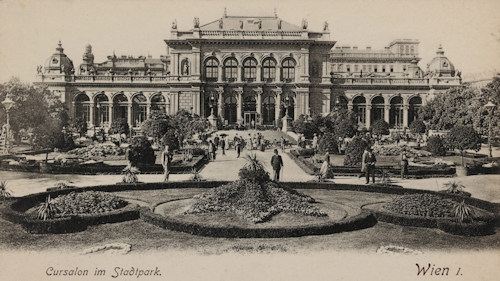
Born in modern-day Hungary when it was part of the extended Austro-Hungarian empire, Franz Lehár (1870-1948) went from a bandmaster in the imperial army to global renown for his operettas and other compositions.
Although he died in Bad Ischl, where he had a summer residence, Lehár spent much of his time between 1899 and 1948 in Vienna. This guide takes you through the main locations in the city relevant to his life, music, and legacy.
- See also:
Lehár: his life
Two of Lehár’s former residences in Vienna have plaques commemorating the composer.
Hackhofergasse

(Located in the outlying suburb of Nussdorf)
The plaque at Hackhofergasse 18 appears outside the so-called Lehár-Schikaneder-Schlössel close to where the Danube enters Vienna. This small summer palais still contains parts that date back to the early 18th-century.
The property once belonged to Emanuel Schikaneder, founder of the Theater an der Wien and librettist for Mozart’s The Magic Flute. Lehár acquired the Schlössel in 1932.
Theobaldgasse

(Located in the 6th district close to the centre)
The plaque at Theobaldgasse 16 sits inside the front door and mentions (I think) his support of those who fell into financial difficulty through no fault of their own.
Museum, Diglas & Sperl

(Adolf Loos originally designed this coffee house)
Like most people of an artistic bent, Lehár would have spent time in Vienna’s coffee houses. He was, for example, a regular at Café Museum (on Operngasse), Café Diglas (on Wollzeile), and Café Sperl (on Gumpendorfer Straße), according to the websites of these coffee houses.
Lehár: his music
The young composer arrived in Vienna more or less for good in 1899 as an army bandmaster, then left the military a couple of years later to pursue a career in music that would make him famous and wealthy.
In those first two or three years, Lehár’s regimental Musikkapelle gave regular concerts.
Newspaper advertisements talked up appearances by the “complete military band of the infantry regiment Grand Duke Michael of Russia No.26 under the baton of Franz Lehár” (my translation).
Zum Wilden Mann

(Found at Währinger Straße 85)
It seems the Zum Wilder Mann establishment regularly put on such events. The address has a same-named restaurant today; this continues a long gastronomic tradition, even if the building “only” dates back to the late-19th century.
Kursalon

(Postcard of the Kursalon around about the time Lehár performed there with the regimental band. C. Ledermann jun. (Producer); Wien Museum Inv.-Nr. 53845/6, excerpt reproduced with permission under the terms of the CC0 licence)
Another location for Lehár’s military concerts was the Kursalon, still a popular venue for Mozart and Strauss concerts today.
Lehár conducted there, for example, on November 22nd, 1900, at a benefit concert for the bandmaster pension fund and in 1901 at an evening of entertainment organised by the Viennese Hungarian National Association.
Theater an der Wien

(Famously hosted the 1805 premiere of Beethoven’s Fidelio)
The public saw many of Lehár’s works for the very first time at the Theater an der Wien. The operetta The Merry Widow, for example, enjoyed its world premiere there on December 30th, 1905, with Lehár conducting.
The next day, the Die Zeit newspaper wrote (my translation):
The Merry Widow was first performed yesterday to rapturous applause. It demonstrates the merits in all their unadulterated purity that Lehár can thank for his great successes to date.
The opera house hosted world premieres of works by many other well-known composers, too, not least Beethoven and Strauss.
Staatsoper

(View from the Albertina)
Lehár’s Giudetta premiered under Lehár’s musical direction at the famous State Opera House on January 20th, 1934. Further performances followed until 1938 and again from 1951-1953.
That was the first time the Staatsoper had hosted one of the composer’s works and it seems not everyone was pleased at his incursion onto the hallowed Staatsoper stage. The Illustrierte Kronen Zeitung described the raucous ovations and noted (my translation):
It was a triumph for his popularity over the somewhat cowardly pedants who feared the desecration of the opera house through a Lehár premiere.
Apollo Kino

(Now a modern cinema)
You might be forgiven for blinking at a connection between IMAX screens and a composer of operettas.
The Apollo Kino at Gumpendorfer Straße 63 began showing movies in 1929, succeeding the Apollo Theatre at the same location where the likes of the Mata Hari once appeared. The first performance of Lehár’s Tangokönigin (The Tango Queen) took place there on September 9th, 1921.
Many other sites of Lehár premieres no longer exist, like the Carltheater, Johann Strauß-Theater, or Bürgertheater.
Lehár: memorials & more
Franz Lehár memorial

(Lehár’s bust is just behind the Kursalon)
The Stadtpark park contains numerous monuments and memorials to composers closely associated with Vienna. The Lehár memorial features a stone bust designed by the Austrian sculptor Franz Anton Coufal.
The unveiling took place on April 29th, 1980 in the presence of the then Austrian president, Rudolf Kirchschläger.
Lehárgasse

(Today’s road is university territory)
The city named a street in Lehár’s honour in 1948, shortly after the composer’s death. Lehárgasse’s artistic connections include more than its name. You have, for example (at the time of writing):
- The back end of the Theater an der Wien
- Offices of the Wiener Festwochen arts festival. Look to their neighbour for some architecture from the Wiener Moderne era by Max Fabiani, who also designed the Urania building
- The 19th-century depot for storing stage sets etc. for the former court theater. The building’s now part of the Academy of Fine Arts Vienna
Franz Lehár map
All the places mentioned above appear on this map:
Watch this space, as I add more locations in the future.